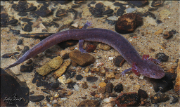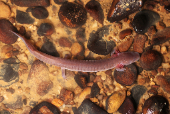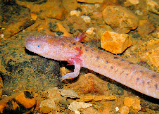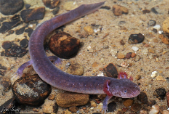 |
Big Mouth Cave Salamander Range Map
|
|
|
 |
 |
 |
 |
 |
 |
 |
Big Mouth Cave Salamander Video
No Video Available.
|
|
|
 |
 |
 |
 |
 |
 |
 |
Big Mouth Cave Salamander Juvenile
Want to Contribute a photo of a Juvenile Big Mouth Cave Salamander?
Email Us
|
|
|
 |
 |
 |
 |
 |
 |
|
Big Mouth Cave Salamander (G. p. necturoides)
Description: The Big Mouth Salamander, G. p. necturoides, differs from G. p. palleucus by having one or two additional costal grooves (usually 18 costal grooves, sometimes 19 in G. p. necturoides; usually 17 costal grooves, sometimes 18 in G. p. palleucus) and by its darker, spotted coloration. G. p. necturoides ranges in color from a russet brown to dark brown to deep purple-brown on the dorsum, with numerous blackish spots that extend from the level of the jaw down to the anterior third of the tail. A dark chevron-like pattern is sometimes present. The venter is pearl-gray, with rosy coloration at the limb insertions and the vent. Two parallel lateral rows of small white dots, corresponding to the costal spaces, run along the sides from the axilla onto the basal half of the tail. A distinct, pale cheek stripe extends from the base of the most ventral gill ramus onto the side of the head. Gills are a deep brilliant red and extend back to the fourth costal groove. Between adpressed limbs, 7 to 8 costal grooves are visible.
Habitat: Adults have been found in caves with streams, rimstone pools, stream runs and pools, and pools isolated by receding water. Substrates can be rock, gravel, sand, or mud. Water is usually clear and free of sediment. Sinkholes are an important habitat component because they allow detritus inflow, which sustains large invertebrate populations.
Range: G. p. necturoides is known from several localities in the upper Elk River watershed, within the Big Mouth-Big Room Cave system, in the Eastern Highland Rim of Grundy Co., TN
Found in these States:
TN
Diet: Stomach contents of 19 specimens from several caves included oligochaetes, amphipods, isopods, crayfish, cladocerans, beetles, stoneflies, mayflies, dipterans, caddisflies, thrips, and two conspecific salamanders.
Reproduction: The breeding season is not known, but it was reported that an adult male was found with a spermatophore protruding from its cloaca in 1954. It has bees suggested that females have irregular breeding patterns and may skip one or more years between breeding. It is also suggested that females oviposit in autumn or early winter, based on discovery of small hatchlings on December 21 and February 15. Eggs have never been found and its nesting biology is unknown. Growth rates are probably slow and larvae may take many years to become sexually mature.
Status: Listed as Vulnerable because its Area of Occupancy is less than 2,000 km2, its distribution is severely fragmented, and there is continuing decline in the extent and quality of its habitat, and the number of mature individuals, in Tennessee, Alabama and Georgia.
»» Kingdom: Animalia - Animals
»» Phylum: Chordata - Chordates
»» Subphylum: Vertebrata - Vertebrates
»» Class: Amphibia - (Amphibians)
»» Order: Caudata - Salamanders
»» Family: Plethodontidae - Lungless Salamanders
»» Genus: Gyrinophilus
»» Species: Gyrinophilus palleucus - Tennessee Cave Salamanders
»» Subspecies: G. p. necturoides - Big Mouth Cave Salamander
This article uses material from the Wikipedia article "Gyrinophilus palleucus necturoides", which is released under the Creative Commons Attribution-Share-Alike License 3.0. Content may have been omitted from the original, but no content has been changed or extended.
|
|











